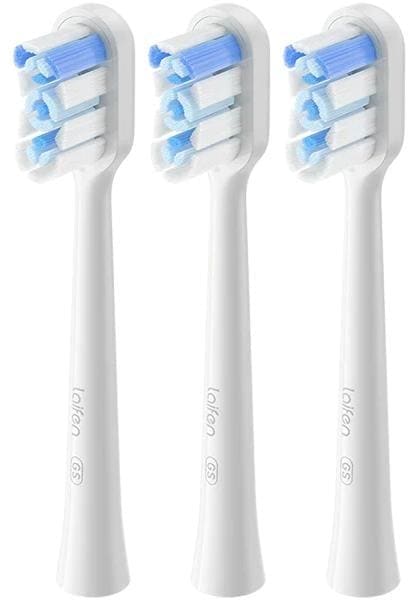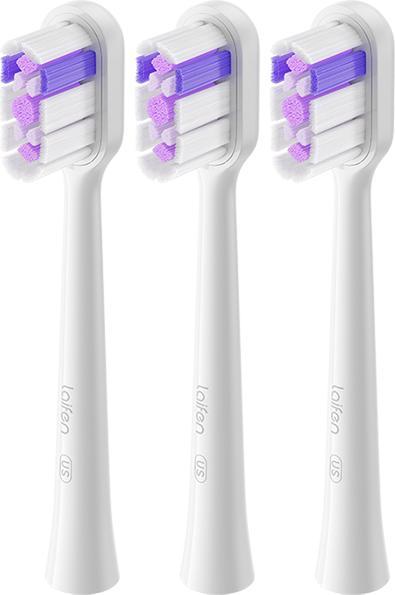

Oscillation, vibration and ultrasound – can the Laifen Wave really do it all?
This electric toothbrush not only looks downright fantastic, it also cleans your teeth gently and thoroughly. I tried out the titanium model and am impressed.
The Laifen Wave came in second and was rated «Good» by German consumer organisation «Stiftung Warentest» in its electric toothbrush ranking published last year. If the battery were replaceable, it would’ve shared first place with the iO Series 3N from Oral-B, as the two electric toothbrushes got the same rating for their cleaning action. But can a hybrid system really be that good? Laifen sent me a test model, which I was happy to give a go.
Apple-like unboxing
When I opened the cardboard box, I was amazed. The white packaging with an embossed outline of the toothbrush is very appealing and reminded me of the unboxing experience of my phone. All of this for a toothbrush? Not bad. In addition to the toothbrush, six brush heads and a charging cable with a USB-C to USB-A adapter are included.
It’s what’s on the inside that counts
It’s not just the packaging that’s impressive, the contents are too. The case is made of titanium and makes a high-quality and sturdy impression with its matt silver look. With the brush head, the toothbrush is 20.5 centimetres long. That makes it just three centimetres shorter than my Philips Sonicare Series 3100. But these three centimetres make all the difference, as I can put the Laifen in my toothbrush glass under the mirror cabinet. This means there’s less stuff taking up space in my already rather cramped bathroom.


Oscillation, sonic and even ultrasonic cleaning?
The Wave is a kind of hybrid between an oscillating brush and a sonic toothbrush. Although it doesn’t strictly rotate, it swivels back and forth at a 60-degree angle, vibrating at the same time. This method is designed to combine the targeted cleaning of an oscillating toothbrush with the gentle cleaning provided by the vibrations of a sonic toothbrush. It cleans particularly thoroughly and gently at the point where the gums meet the teeth. The toothbrush also has a high-frequency mode that turns it into an ultrasonic one at the touch of a button. Want to learn more about the differences between these three electric toothbrush types and find out which one is right for you? Then check out this article in which I explain the differences.
Toothbrush modes to suit your needs
The toothbrush has three preset programmes by default. You can switch between them with a light double-click of the start button. If you want to personalise the cleaning modes, you have to log into the Laifen app. As soon as the brush is connected, you can customise the three modes to your liking. You can set the toothbrush to give off a signal when you need to move on to the next brushing area or determine how long your brushing time should be. In addition, vibration intensity, swivel amplitude, i.e. the angle at which the brush rotates, and swivel speed can be individually adjusted on a scale ranging from one to ten.

It takes me a few attempts to get the settings right for me. In the end, I figure out that I like a low vibration intensity and the lowest possible oscillation range and speed. The oscillation range can’t be switched off completely. I personalise the settings in the second mode to a stronger vibration and a low oscillation range so that I can give my teeth a second scrub if necessary. And the third mode I don’t need.
Ultrasonic mode
You can add a fourth mode, which is the high frequency one, to the three existing modes in the app. This turns the Wave into an ultrasonic toothbrush. According to the manufacturer, the toothbrush manages a frequency of 66,000 vibrations per minute. The sound that makes is like a dentist drilling holes or a construction worker using a circular saw. In theory, ultrasound should clean your teeth particularly gently, almost without touching them. But according to German consumer organisation «Stiftung Warentest», this method hasn’t yet proven itself sufficiently in hands-on tests. Personally, I find the noise too loud, the vibration tickles my mouth too much and my teeth don’t feel completely clean after I’m done. So I only used this mode twice in my test. However, the Wave has one advantage over other ultrasonic toothbrushes: it works without special ultrasonic toothpaste.
The right brush head
To date, Laifen has developed three different brush heads, one of each is included with each toothbrush for you to try out. The titanium model also comes with two interchangeable Gum Care attachments. The Gum Care brush heads have softer bristles, which are meant to be gentle on the gums, but also clean less intensively. Thorough cleaning is done by the Super-clean brush head, which is harder but also more effective. Laifen recommends the Ultra-whitening heads to, well, whiten your teeth.

I like the Super-clean best. Although its bristles are harder, they feel softer to me than the ones on the Gum Care brush head. Thanks to its slightly U-shaped bristles, I can reach the spaces between my teeth without applying much pressure. The Ultra-whitening brush head is hard and scrubs a little too roughly for my taste. But this is probably necessary to mechanically whiten teeth.
I’m very happy with the fresh feeling after cleaning. My teeth are really clean and the bristles are gentle on the gums. The only thing I’m missing is a signal letting me know I’m applying too much pressure. When I’m not focussed, it often happens that I press the brush head too hard against my teeth. This isn’t good, as sonic toothbrushes work best with low pressure.
Same models, different prices
Searching for Laifen Wave toothbrushes in our shop reveals that all models have the same features and only differ in price and design. I asked the manufacturer about this and they explained that the difference lies in the material and weight of the toothbrushes. The stainless steel model is the heaviest, followed by titanium and aluminium. The lightest and cheapest are the ABS models, which have a plastic housing.
Titanium, which is the most expensive model, features six instead of three brush heads and comes in a futuristic storage box. It’s also the most waterproof of them all. However, there are no differences between the models in terms of functions and battery life. So if you’re after an affordable model, you’ll get to keep all the functions and will only have to make do without the sturdy metal design.

Incredibly long battery life
The battery turns out to be a real surprise. It’s fully charged after a quick charge of 2.5 hours. This has been enough juice to brush my teeth for weeks, even though I’ve increased my brushing time to three minutes. According to the manufacturer, a full charge should last up to 45 days if you’re using your toothbrush twice a day for two minutes at a time. That’s because the toothbrush only switches on when you pick it up. If it’s left untouched for three minutes, it automatically switches to power-saving mode.

Unfortunately, the Wave doesn’t come with a charging station. That’s why I have to lie my brush down to charge. But seeing that it only needs a charge every 45 days, it’s not the end of the world. However, this could become annoying should the brush’s battery lose some of its power over time. Unfortunately, the battery can’t be replaced. Once the battery’s dead, the Wave needs to be chucked. That’s why «Stiftung Warentest» deducted points. Only time will tell how long the toothbrush will last.
In a nutshell
Elegant, effective hybrid system
Pro
- Great design
- Customisable modes
- More compact than competitor models
- Fast charging
- Long battery life
- High-frequency mode can be used without ultrasonic toothpaste
Contra
- Doesn’t warn you when you’re pressing too hard
- No charging station
Painting the walls just before handing over the flat? Making your own kimchi? Soldering a broken raclette oven? There's nothing you can't do yourself. Well, perhaps sometimes, but I'll definitely give it a try.





